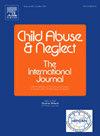The impact of race, ethnicity, and socioeconomic status on early adolescent sleep disturbances for youth exposed to adverse childhood experiences
IF 3.4
2区 心理学
Q1 FAMILY STUDIES
引用次数: 0
Abstract
Background
Adverse childhood experiences (ACEs) may increase the risk for adolescent sleep disturbances, though the impact of race, ethnicity, and socioeconomic status (SES) remains unclear.
Objective
We sought to determine the direct and moderating impact of race, ethnicity, family SES, and community SES on sleep disturbances across early adolescence for ACE-exposed youth.
Participants and setting
This secondary analysis used longitudinal Adolescent Brain Cognitive Development Study® data (2016–2022) from youth who experienced ≥1 ACE by age 9–10 years.
Methods
Clinically significant sleep disturbances were identified from the annual parent-reported Sleep Disturbances Scale for Children. Parents reported youths' race, ethnicity, family SES, and community SES at baseline. Multilevel mixed effects logistic regression modeling examined the impact of race, ethnicity, and SES on sleep disturbances over four years among ACE-exposed youth. Adjusted odds ratios with 95 % confidence intervals are presented (adj. OR [95 % CI]).
Results
Among 6661 youth with ACE exposure, 2402 (36.1 %) had clinically significant sleep disturbances at baseline. Multiracial (versus White) youth were 27 % likelier to have clinically significant sleep disturbances over time (adj. OR 1.27 [95 % CI 1.01, 1.59]). Similar results were found for youth exposed to ≥2 family financial adversities (adj. OR 1.50 [95 % CI 1.19, 1.90]). There were no effects of community SES, nor interaction effects of race, ACEs, or SES on sleep disturbances.
Conclusion
While Multiracial youth may experience additional stressors which affect sleep disturbances, regularly assessing family environments and supporting all families to meet basic needs may positively impact adolescent sleep.
种族、民族和社会经济地位对接触不良童年经历的青少年早期睡眠障碍的影响
背景:不良的童年经历(ace)可能会增加青少年睡眠障碍的风险,尽管种族、民族和社会经济地位(SES)的影响尚不清楚。目的:我们试图确定种族、民族、家庭经济地位和社区经济地位对ace暴露青少年青春期早期睡眠障碍的直接和调节影响。参与者和环境:这项二次分析使用了9-10岁时经历≥1次ACE的青少年的纵向青少年大脑认知发展研究®数据(2016-2022)。方法:从每年家长报告的儿童睡眠障碍量表中确定有临床意义的睡眠障碍。父母报告青少年的种族、民族、家庭社会经济地位和社区社会经济地位作为基线。多水平混合效应logistic回归模型检验了种族、民族和社会经济地位对四年内ace暴露青少年睡眠障碍的影响。校正后的优势比为95%置信区间(OR [95% CI])。结果:在6661名ACE暴露的青少年中,2402名(36.1%)在基线时有临床显著的睡眠障碍。随着时间的推移,多种族青年(与白人相比)出现临床显著睡眠障碍的可能性为27%(比值比1.27 [95% CI 1.01, 1.59])。暴露于≥2个家庭财务逆境的青少年也发现了类似的结果(OR为1.50 [95% CI为1.19,1.90])。没有社会经济地位的影响,也没有种族、ace或社会经济地位对睡眠障碍的相互作用。结论:虽然多种族青少年可能会经历影响睡眠障碍的额外压力源,但定期评估家庭环境并支持所有家庭满足基本需求可能会对青少年睡眠产生积极影响。
本文章由计算机程序翻译,如有差异,请以英文原文为准。
求助全文
约1分钟内获得全文
求助全文
来源期刊

Child Abuse & Neglect
Multiple-
CiteScore
7.40
自引率
10.40%
发文量
397
期刊介绍:
Official Publication of the International Society for Prevention of Child Abuse and Neglect. Child Abuse & Neglect The International Journal, provides an international, multidisciplinary forum on all aspects of child abuse and neglect, with special emphasis on prevention and treatment; the scope extends further to all those aspects of life which either favor or hinder child development. While contributions will primarily be from the fields of psychology, psychiatry, social work, medicine, nursing, law enforcement, legislature, education, and anthropology, the Journal encourages the concerned lay individual and child-oriented advocate organizations to contribute.
 求助内容:
求助内容: 应助结果提醒方式:
应助结果提醒方式:


